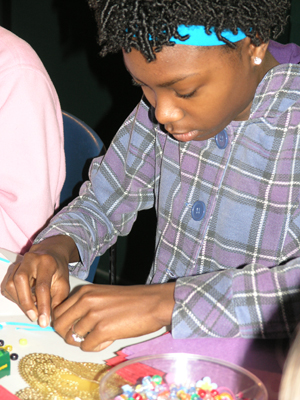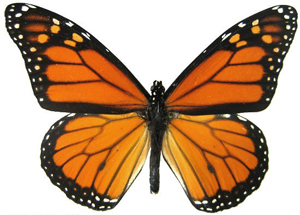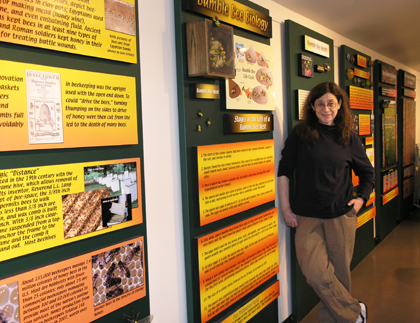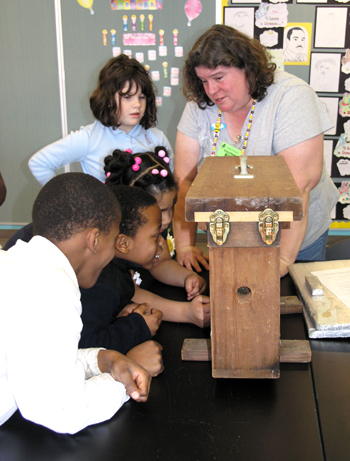Folks From Cradle to Retirement Home Connect With Nature at Pollinatarium
May 1, 2012

A Chicago Public Schools student captures an insect during an activity at the Pollinatarium's prairie habitat.
Imagine a lush green prairie oasis filled with wildflowers. Bees are busily buzzing. Hummingbirds are hovering. A butterfly in search of nectar gracefully floats through the air to alight upon a brightly-colored blossom. Imagine a place where, armed with butterfly nets, “city folks” longing to escape the concrete can get back to nature. Although it sounds too good to be true, it’s not an imaginary place; it’s Illinois’ Pollinatarium, and it’s just a few minutes away on the southern edge of campus.
Since opening its doors in the fall of 2009, the University of Illinois’ Pollinatarium, a public science center devoted to pollination, has helped two to three thousand visitors a year reconnect with nature. Ranging from preschool children to senior citizens—or as Head of Entomology May Berenbaum, describes it, “from the cradle to the retirement home”—groups from day cares; elementary schools; high schools; colleges, such as Parkland; University of Illinois; and even OLLI (mostly senior adults) make the pilgrimage south to take advantage the resources offered by Dr. Berenbaum and her staff. While the majority of visitors are local, guests from as far away as Montana have dropped by to learn about pollinators, perils they face, and what the facility is doing to increase populations of pollinators. Although the audience is diverse, their biggest audience is 2nd to 6th grade classes. In fact, every second grade class in Champaign Unit 4 School District visits the Pollinatarium as one of their class requirements, since it has recently become a vital part of their curriculum. But senior adults have been involved too. Not only has Berenbaum has taught an OLLI (Osher Life-Long Learning Institute) class for seniors, but OLLI volunteers, as well as master gardeners and master naturalists, have contributed to the facility.
All About Bees

A student from Heritage School learns about a bee's anatomy as she creates a "bee" made of beads at the Pollinatarium.
When it comes to outreach to this diverse clientele, Lesley Deem, the hard-working coordinator who manages the Pollinatarium, is busy as a bee. This reporter first met her at an Entomology presentation at Booker T. Washington STEM academy, where she was staffing the popular honeybee station. Despite the hard work, Deem finds working at the facility rewarding: “I like the kids, the bugs, and the plants, so it is all a good combo.”
When large groups of students come to the Pollinatarium for field trips, staff draw upon students from Entomology. Members of Insecta, a registered student organization for undergraduates, have taken on a lot of Pollinatarium responsibilities. In addition to helping make a reference collection of local pollinators, they help keep the museum open on weekends for visitors. In fact, one dedicated graduate student volunteer has been working with the center since he was an undergraduate student. Student volunteers staff learning stations, both inside and outside the facility, where visitors learn about the importance of pollination, perils pollinators face, and hive hierarchy (queen, drones, and worker bees); see bees up close in the observation hive; and capture insects and do bug interviews. Particularly valuable is the opportunity the facility provides students to learn about conservation via hands-on activities in its prairie habitat. According to Berenbaum, students can catch insects, “see which pollinators actually share the community with them, and then see biodiversity first hand, and the conservation message too. We don’t catch them, pin them, and dissect them. We catch them, identify them, and let them go back to their business of pollinating.”

A monarch butterfy
Monarch Motel
The Pollinatarium doesn’t just concentrate on bees. The Pollinatarium hopes to increase the monarch butterfly population by creating a way-station. Each fall, hundreds of millions of monarchs migrate from the U.S. and Canada to overwinter in Mexico and California, where they wait out the winter. When spring returns, so do the monarchs. However, this wonder of the natural world is threatened by loss of habitats in North America at both overwintering sites and the spring and summer breeding ranges. To help out the monarchs, the Pollinatarium plans to increase the numbers and varieties of milk weeds growing in their prairie patch, which is filled with native plants, such as milkweed. Deem reports that local boy scouts and girl scouts have helped them realize this vision by planting natives in the habitat’s woodland edge.
Pollinatarium Is A Testament to Altruism
Despite the center’s value to both the educational and the scientific communities, funding for the center’s start-up and daily operations have come not from federal or state grants, but mostly through altruism. Dubbed by Berenbaum as a “fairy godfather,” businessman and philanthropist Peter Fox adopted the Pollinatarium as a project. He first got interested when he accompanied fourth graders from Thomas Payne School on a field trip to the university. Because these fourth graders were some of the first “bee spotters” (Bee Spotter is Entomology’s citizen-science outreach program), the capstone experience in their unit on bees was a visit to the bean research facility run by Gene Robinson, who knew about Berenbaum’s vision of a public science center and got the two together. Berenbaum credits Fox as the catalyst who made her dream a reality: “It would have not happened without his incredible generosity…he broke down every barrier that we faced. He acquired the expertise we needed.”

May Berenbaum illustrates some of the colorful educational displays created by Mike Jeffords and other volunteers from the Natural History Survey.
Also instrumental in the center’s initial setup was assistance from Illinois’ Natural History Survey. The colorful, eye-catching, yet informative exhibits which decorate the walls were constructed by outreach coordinator, Mike Jeffords, who donated photographic expertise, and his Survey colleagues, while the content came from Jeffords, graduate students, and others associated with Entomology. Berenbaum likens the outpouring of generosity that helped establish the Pollinatarium to—you guessed it—bees.
“Honey bees and bumble bees are social insects, and their societies run on altruism and unselfish behavior. I think it is incredibly apt that this whole outfit runs on altruism.” Berenbaum is also very grateful for the funding from the Chancellor’s Office which funds Leslie Deem’s position halftime.
Berenbaum is also particularly proud of the cookbook they developed as a fundraising activity. “I was despairing on how we were going to keep this running…So one night I decided: ‘Instead of a bake sale, we will put together a cook book.’” Appropriately named, Honey, I Am Home-Made, the cookbook features dessert recipes made with honey, with all of the proceeds going to the Pollinatarium. “So that was fun,” reports Berenbaum. “Nothing I had ever suspected I would do as an entomologist was put together a cookbook!”
Deem’s Dreams

Lesley Deem discusses bee culture with students during an Entomology presentation at Booker T. Washington.
Like her boss, May Berenbaum, Lesley Deem is also passionate about pollination and raising public awareness. One of her long-time dreams is to start a public initiative to help pollinators. “I want to do something called ‘Pathway for Pollinators,’ and get school kids, and individuals, and groups starting to plant strips of prairie plants to feed the pollinators and to feed the other wild life.”
In the future, Deem also hopes to coordinate with the Entomology and Landscape Architecture Departments on a research project involving garden plots designed with a variety of plants. An entomology student would measure visitation rates of different pollinators to the various plants, whereas the landscape architecture student would survey people visiting the gardens to determine what plants they found esthetically pleasing. For example, says Deem, "Some native plants are big and weedy, and people are not going to want those in their yard. Since we are trying to encourage people to plant things that would be good for the bees and for the butterflies and pollinators, we also want to find things that would be appealing to people to plant.”
Pollinatarium staff are also trying to raise money for an outdoor pavilion to be used for teaching. For example, during field trips, schools usually drop off two classes; one does activities in the yard, while the other is in the building. However, on days when it starts to drizzle, students who are outside need a dry spot where they can get out of the rain while they work on papers and draw pictures of the insects.
And finally, Pollinatarium staff hope to build a memorial swallow tail garden in memory of Art Zangerl, a department member who passed away this past winter.
Pollinatarium—One of a Kind?
Is Illinois’ Pollinatarium the only one of its kind? Berenbaum believes that it is. “To my knowledge, it is the only free-standing science center devoted to pollinators. There are zoos and other science centers that have a room or a section, but…this is it.” As for the word, pollinatarium, Berenbaum almost can lay claim to it. “I thought that I had invented the word, but I discovered one prior use in a bioscience article going back like 30 years. I don’t think it ever appeared again; that’s Google for you.” So although Berenbaum doesn’t appear in Google as the person who coined the word, the center still has some claim to fame in the well-known search engine. When I queried, “So you don’t appear in Google, huh?” she replied, “Well, we do now; I mean, if you Google pollinatarium, this is the one that they find.” So I did. She was right.
Author/Photographer: Elizabeth Innes, Communications Specialist, I-STEM Education Initiative
More: Entomology, Science Center, 2012













.jpg)
















